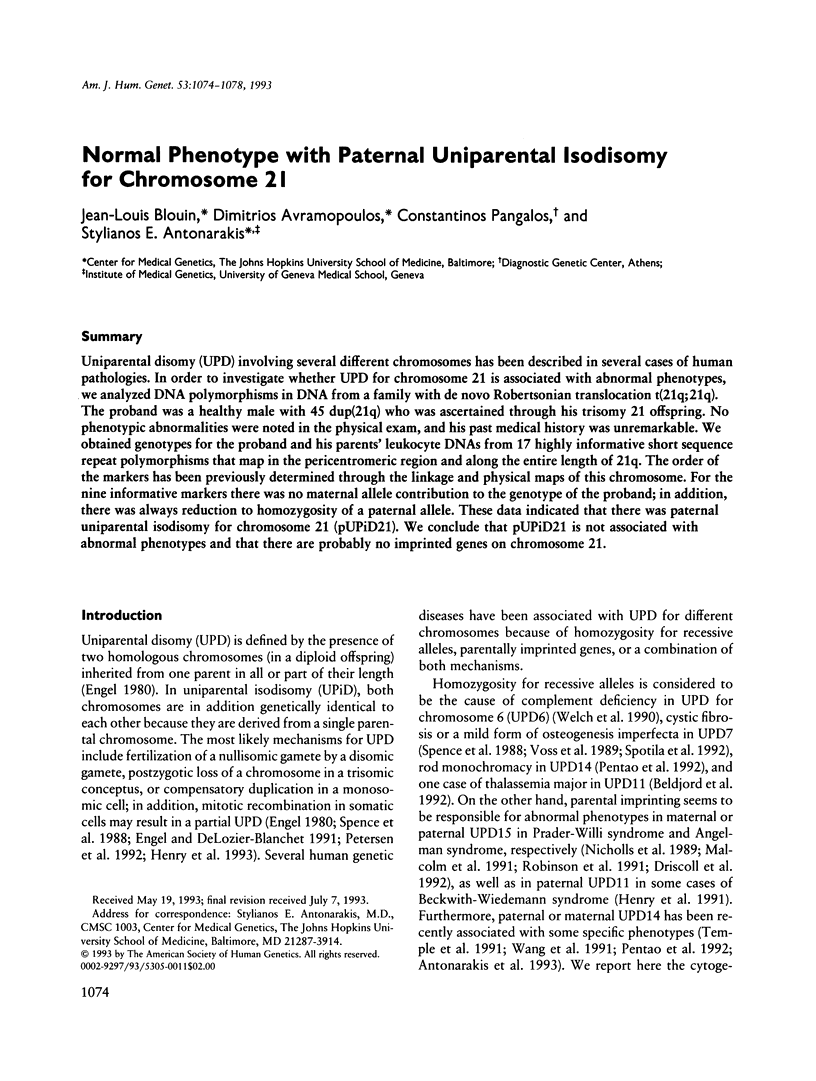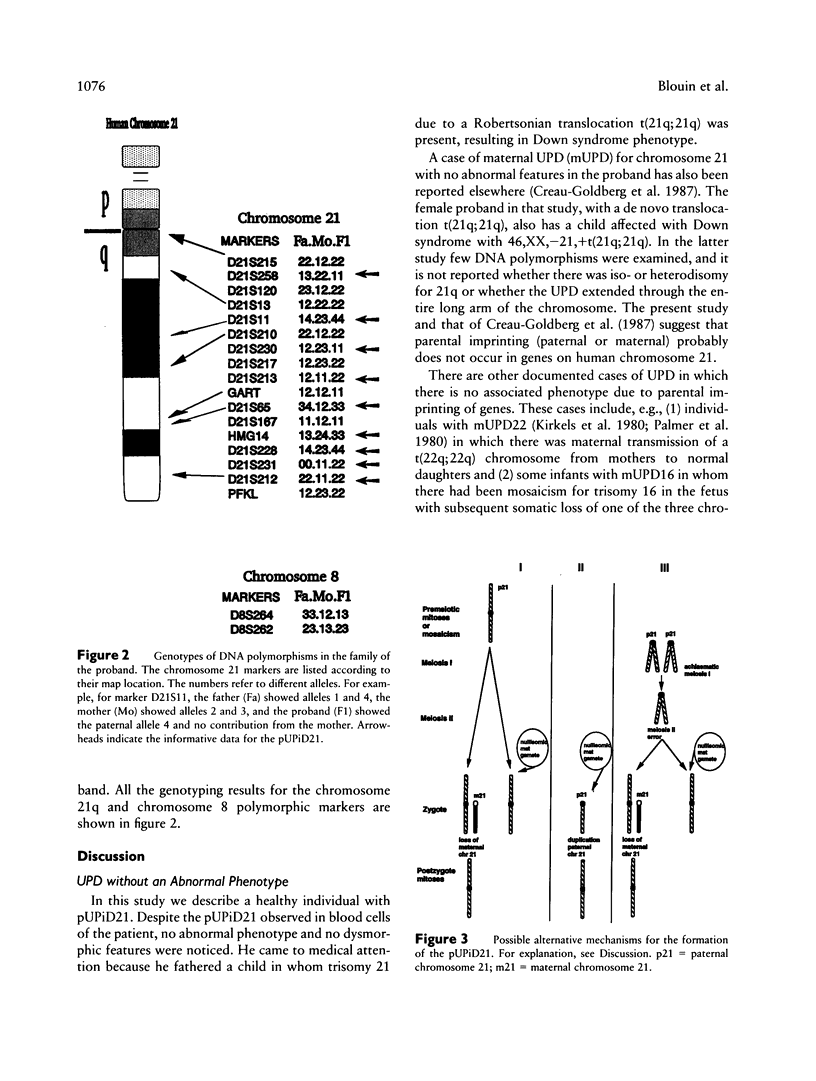Abstract
Uniparental disomy (UPD) involving several different chromosomes has been described in several cases of human pathologies. In order to investigate whether UPD for chromosome 21 is associated with abnormal phenotypes, we analyzed DNA polymorphisms in DNA from a family with de novo Robertsonian translocation t(21q;21q). The proband was a healthy male with 45 dup(21q) who was ascertained through his trisomy 21 offspring. No phenotypic abnormalities were noted in the physical exam, and his past medical history was unremarkable. We obtained genotypes for the proband and his parents' leukocyte DNAs from 17 highly informative short sequence repeat polymorphisms that map in the pericentromeric region and along the entire length of 21q. The order of the markers has been previously determined through the linkage and physical maps of this chromosome. For the nine informative markers there was no maternal allele contribution to the genotype of the proband; in addition, there was always reduction to homozygosity of a paternal allele. These data indicated that there was paternal uniparental isodisomy for chromosome 21 (pUPiD21). We conclude that pUPiD21 is not associated with abnormal phenotypes and that there are probably no imprinted genes on chromosome 21.
Full text
PDF




Images in this article
Selected References
These references are in PubMed. This may not be the complete list of references from this article.
- Antonarakis S. E., Blouin J. L., Maher J., Avramopoulos D., Thomas G., Talbot C. C., Jr Maternal uniparental disomy for human chromosome 14, due to loss of a chromosome 14 from somatic cells with t(13;14) trisomy 14. Am J Hum Genet. 1993 Jun;52(6):1145–1152. [PMC free article] [PubMed] [Google Scholar]
- Antonarakis S. E. Third International Workshop on Human Chromosome 21. Genomics. 1992 Dec;14(4):1126–1132. doi: 10.1016/s0888-7543(05)80148-x. [DOI] [PubMed] [Google Scholar]
- Beldjord C., Henry I., Bennani C., Vanhaeke D., Labie D. Uniparental disomy: a novel mechanism for thalassemia major. Blood. 1992 Jul 1;80(1):287–289. [PubMed] [Google Scholar]
- Bennett P., Vaughan J., Henderson D., Loughna S., Moore G. Association between confined placental trisomy, fetal uniparental disomy, and early intrauterine growth retardation. Lancet. 1992 Nov 21;340(8830):1284–1285. doi: 10.1016/0140-6736(92)92980-t. [DOI] [PubMed] [Google Scholar]
- Berger C. N., Epstein C. J. Genomic imprinting: normal complementation of murine chromosome 16. Genet Res. 1989 Dec;54(3):227–230. doi: 10.1017/s001667230002869x. [DOI] [PubMed] [Google Scholar]
- Créau-Goldberg N., Gegonne A., Delabar J., Cochet C., Cabanis M. O., Stehelin D., Turleau C., de Grouchy J. Maternal origin of a de novo balanced t(21q21q) identified by ets-2 polymorphism. Hum Genet. 1987 Aug;76(4):396–398. doi: 10.1007/BF00272452. [DOI] [PubMed] [Google Scholar]
- Driscoll D. J., Waters M. F., Williams C. A., Zori R. T., Glenn C. C., Avidano K. M., Nicholls R. D. A DNA methylation imprint, determined by the sex of the parent, distinguishes the Angelman and Prader-Willi syndromes. Genomics. 1992 Aug;13(4):917–924. doi: 10.1016/0888-7543(92)90001-9. [DOI] [PubMed] [Google Scholar]
- Dworniczak B., Koppers B., Kurlemann G., Holzgreve W., Horst J., Miny P. Uniparental disomy with normal phenotype. Lancet. 1992 Nov 21;340(8830):1285–1285. doi: 10.1016/0140-6736(92)92981-k. [DOI] [PubMed] [Google Scholar]
- Economou E. P., Bergen A. W., Warren A. C., Antonarakis S. E. The polydeoxyadenylate tract of Alu repetitive elements is polymorphic in the human genome. Proc Natl Acad Sci U S A. 1990 Apr;87(8):2951–2954. doi: 10.1073/pnas.87.8.2951. [DOI] [PMC free article] [PubMed] [Google Scholar]
- Engel E. A new genetic concept: uniparental disomy and its potential effect, isodisomy. Am J Med Genet. 1980;6(2):137–143. doi: 10.1002/ajmg.1320060207. [DOI] [PubMed] [Google Scholar]
- Engel E., DeLozier-Blanchet C. D. Uniparental disomy, isodisomy, and imprinting: probable effects in man and strategies for their detection. Am J Med Genet. 1991 Sep 15;40(4):432–439. doi: 10.1002/ajmg.1320400411. [DOI] [PubMed] [Google Scholar]
- Henry I., Bonaiti-Pellié C., Chehensse V., Beldjord C., Schwartz C., Utermann G., Junien C. Uniparental paternal disomy in a genetic cancer-predisposing syndrome. Nature. 1991 Jun 20;351(6328):665–667. doi: 10.1038/351665a0. [DOI] [PubMed] [Google Scholar]
- Henry I., Puech A., Riesewijk A., Ahnine L., Mannens M., Beldjord C., Bitoun P., Tournade M. F., Landrieu P., Junien C. Somatic mosaicism for partial paternal isodisomy in Wiedemann-Beckwith syndrome: a post-fertilization event. Eur J Hum Genet. 1993;1(1):19–29. doi: 10.1159/000472384. [DOI] [PubMed] [Google Scholar]
- Kalousek D. K., Langlois S., Barrett I., Yam I., Wilson D. R., Howard-Peebles P. N., Johnson M. P., Giorgiutti E. Uniparental disomy for chromosome 16 in humans. Am J Hum Genet. 1993 Jan;52(1):8–16. [PMC free article] [PubMed] [Google Scholar]
- Kirkels V. G., Hustinx T. W., Scheres J. M. Habitual abortion and translocation (22q;22q): unexpected transmission from a mother to her phenotypically normal daughter. Clin Genet. 1980 Dec;18(6):456–461. doi: 10.1111/j.1399-0004.1980.tb01794.x. [DOI] [PubMed] [Google Scholar]
- Malcolm S., Clayton-Smith J., Nichols M., Robb S., Webb T., Armour J. A., Jeffreys A. J., Pembrey M. E. Uniparental paternal disomy in Angelman's syndrome. Lancet. 1991 Mar 23;337(8743):694–697. doi: 10.1016/0140-6736(91)90278-w. [DOI] [PubMed] [Google Scholar]
- McInnis M. G., Chakravarti A., Blaschak J., Petersen M. B., Sharma V., Avramopoulos D., Blouin J. L., König U., Brahe C., Matise T. C. A linkage map of human chromosome 21:43 PCR markers at average intervals of 2.5 cM. Genomics. 1993 Jun;16(3):562–571. doi: 10.1006/geno.1993.1231. [DOI] [PubMed] [Google Scholar]
- Nicholls R. D., Knoll J. H., Butler M. G., Karam S., Lalande M. Genetic imprinting suggested by maternal heterodisomy in nondeletion Prader-Willi syndrome. Nature. 1989 Nov 16;342(6247):281–285. doi: 10.1038/342281a0. [DOI] [PMC free article] [PubMed] [Google Scholar]
- O'Brien S. J., Womack J. E., Lyons L. A., Moore K. J., Jenkins N. A., Copeland N. G. Anchored reference loci for comparative genome mapping in mammals. Nat Genet. 1993 Feb;3(2):103–112. doi: 10.1038/ng0293-103. [DOI] [PubMed] [Google Scholar]
- Palmer C. G., Schwartz S., Hodes M. E. Transmission of a balanced homologous t(22q;22q) translocation from mother to normal daughter. Clin Genet. 1980 Jun;17(6):418–422. doi: 10.1111/j.1399-0004.1980.tb00173.x. [DOI] [PubMed] [Google Scholar]
- Pentao L., Lewis R. A., Ledbetter D. H., Patel P. I., Lupski J. R. Maternal uniparental isodisomy of chromosome 14: association with autosomal recessive rod monochromacy. Am J Hum Genet. 1992 Apr;50(4):690–699. [PMC free article] [PubMed] [Google Scholar]
- Petersen M. B., Bartsch O., Adelsberger P. A., Mikkelsen M., Schwinger E., Antonarakis S. E. Uniparental isodisomy due to duplication of chromosome 21 occurring in somatic cells monosomic for chromosome 21. Genomics. 1992 Jun;13(2):269–274. doi: 10.1016/0888-7543(92)90242-k. [DOI] [PubMed] [Google Scholar]
- Petersen M. B., Schinzel A. A., Binkert F., Tranebjaerg L., Mikkelsen M., Collins F. A., Economou E. P., Antonarakis S. E. Use of short sequence repeat DNA polymorphisms after PCR amplification to detect the parental origin of the additional chromosome 21 in Down syndrome. Am J Hum Genet. 1991 Jan;48(1):65–71. [PMC free article] [PubMed] [Google Scholar]
- Reeves R. H., Miller R. D. Mouse chromosome 16. Mamm Genome. 1992;3(Spec No):S233–S240. doi: 10.1007/BF00648434. [DOI] [PubMed] [Google Scholar]
- Robinson W. P., Bottani A., Xie Y. G., Balakrishman J., Binkert F., Mächler M., Prader A., Schinzel A. Molecular, cytogenetic, and clinical investigations of Prader-Willi syndrome patients. Am J Hum Genet. 1991 Dec;49(6):1219–1234. [PMC free article] [PubMed] [Google Scholar]
- Searle A. G., Peters J., Lyon M. F., Hall J. G., Evans E. P., Edwards J. H., Buckle V. J. Chromosome maps of man and mouse. IV. Ann Hum Genet. 1989 May;53(Pt 2):89–140. doi: 10.1111/j.1469-1809.1989.tb01777.x. [DOI] [PubMed] [Google Scholar]
- Silver L. M., Artzt K., Barlow D., Fischer-Lindahl K., Lyon M. F., Klein J., Snyder L. Mouse chromosome 17. Mamm Genome. 1992;3(Spec No):S241–S260. doi: 10.1007/BF00648435. [DOI] [PubMed] [Google Scholar]
- Spence J. E., Perciaccante R. G., Greig G. M., Willard H. F., Ledbetter D. H., Hejtmancik J. F., Pollack M. S., O'Brien W. E., Beaudet A. L. Uniparental disomy as a mechanism for human genetic disease. Am J Hum Genet. 1988 Feb;42(2):217–226. [PMC free article] [PubMed] [Google Scholar]
- Spotila L. D., Sereda L., Prockop D. J. Partial isodisomy for maternal chromosome 7 and short stature in an individual with a mutation at the COL1A2 locus. Am J Hum Genet. 1992 Dec;51(6):1396–1405. [PMC free article] [PubMed] [Google Scholar]
- Taylor B. A., Frankel W. N., Reeves R. H. Mouse chromosome 10. Mamm Genome. 1992;3(Spec No):S153–S161. doi: 10.1007/BF00648428. [DOI] [PubMed] [Google Scholar]
- Temple I. K., Cockwell A., Hassold T., Pettay D., Jacobs P. Maternal uniparental disomy for chromosome 14. J Med Genet. 1991 Aug;28(8):511–514. doi: 10.1136/jmg.28.8.511. [DOI] [PMC free article] [PubMed] [Google Scholar]
- Voss R., Ben-Simon E., Avital A., Godfrey S., Zlotogora J., Dagan J., Tikochinski Y., Hillel J. Isodisomy of chromosome 7 in a patient with cystic fibrosis: could uniparental disomy be common in humans? Am J Hum Genet. 1989 Sep;45(3):373–380. [PMC free article] [PubMed] [Google Scholar]
- Wang J. C., Passage M. B., Yen P. H., Shapiro L. J., Mohandas T. K. Uniparental heterodisomy for chromosome 14 in a phenotypically abnormal familial balanced 13/14 Robertsonian translocation carrier. Am J Hum Genet. 1991 Jun;48(6):1069–1074. [PMC free article] [PubMed] [Google Scholar]
- Weissenbach J., Gyapay G., Dib C., Vignal A., Morissette J., Millasseau P., Vaysseix G., Lathrop M. A second-generation linkage map of the human genome. Nature. 1992 Oct 29;359(6398):794–801. doi: 10.1038/359794a0. [DOI] [PubMed] [Google Scholar]
- Welch T. R., Beischel L. S., Choi E., Balakrishnan K., Bishof N. A. Uniparental isodisomy 6 associated with deficiency of the fourth component of complement. J Clin Invest. 1990 Aug;86(2):675–678. doi: 10.1172/JCI114760. [DOI] [PMC free article] [PubMed] [Google Scholar]



